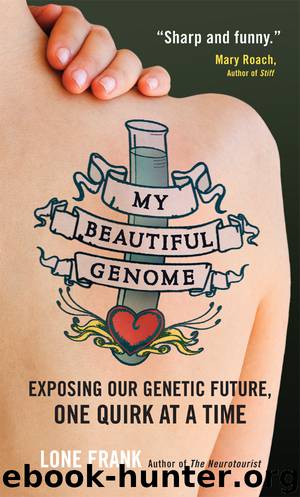My Beautiful Genome by Lone Frank

Author:Lone Frank
Language: eng
Format: epub
Publisher: Oneworld Publications
Published: 2011-11-23T16:00:00+00:00
I’M THINKING ABOUT depression on the train from Washington, DC, to Richmond, Virginia. I’m on my way to meet Kenneth Kendler, who has been a psychiatric epidemiologist and a professor at Virginia Commonwealth University since 1983. I’ve met him before. Many years ago, he graciously granted me an interview at a fancy Copenhagen restaurant, where I enjoyed a big, very rare steak, while Kendler stuck to his vegetarian diet.
The train trip from the nation’s capital is typical Amtrak. It takes a miserably long time; the train moves at a snail’s pace, and the temperature inside is freezing cold, to counteract the sticky humidity of June. A number of passengers are wrapped in jackets and cardigans, a rebuke to the summer that ambles by outside. The view from the window is unvaryingly green, so there is not much to do but read. For entertainment, I can choose from Physiological Medicine, JAMA – the Journal of the American Medical Association, General Archives of Psychiatry, and the American Journal of Psychiatry. I leaf through each in turn, and then my gaze falls randomly on the conclusion at the bottom of the first page of an article in the last journal: “Major depression is a familial disorder, and its familiality mostly or entirely results from genetic influences.”
I scan further up the page. It says that a number of studies of depressive families show that the condition’s heritability is around forty percent. They could have aptly studied my family. Just my first-degree relations would have provided reams of quality data. For instance, there is an unbroken line from my maternal great-grandfather to me, all of whom were hit by depression. Great-grandpa Marinus Hansen – whom I only know from family stories and his glum, grey photo portrait – put a bullet in his forehead; his daughter, my maternal grandmother, was almost subjected to a lobotomy. It was a ghastly but heart-warming story, which I loved to be told as a child.
“Mommy, mommy, tell me about the time your mother almost got lobotomized,” I would beg, and my mother would happily relate the tale. It was, after all, something she’d experienced as a teenager. At that time, my grandmother, who had worked insanely hard for her whole life, broke down into a deep depression. So deep, she had to be hospitalized, and for months just lay in her bed. No one could do anything. Not that they didn’t try. The chief surgeon was particularly generous with electro-shock therapy, but nothing helped. Mrs. Frank was too sick to act for herself, and finally the doctors recommended that the family try one last procedure: psychosurgery.
In the 1950s, medical reports indicated that a lobotomy – where they rummage around with a thin metal spatula in the patient’s frontal lobes, cutting random nerve paths – could relieve very severe depression or, at any rate, bring patients to a state in which they could be sent home. The chief surgeon suggested they give it a go. My maternal grandfather, who knew nothing about psychosurgery or medical treatments in general, was in favor of signing the papers.
Download
This site does not store any files on its server. We only index and link to content provided by other sites. Please contact the content providers to delete copyright contents if any and email us, we'll remove relevant links or contents immediately.
Hit Refresh by Satya Nadella(9041)
When Breath Becomes Air by Paul Kalanithi(8337)
The Girl Without a Voice by Casey Watson(7824)
A Court of Wings and Ruin by Sarah J. Maas(7654)
Do No Harm Stories of Life, Death and Brain Surgery by Henry Marsh(6891)
Shoe Dog by Phil Knight(5147)
Hunger by Roxane Gay(4869)
The Rules Do Not Apply by Ariel Levy(4868)
A Higher Loyalty: Truth, Lies, and Leadership by James Comey(4851)
Tuesdays with Morrie by Mitch Albom(4696)
Everything Happens for a Reason by Kate Bowler(4680)
The Immortal Life of Henrietta Lacks by Rebecca Skloot(4528)
Millionaire: The Philanderer, Gambler, and Duelist Who Invented Modern Finance by Janet Gleeson(4386)
How to Change Your Mind by Michael Pollan(4292)
All Creatures Great and Small by James Herriot(4236)
The Money Culture by Michael Lewis(4083)
Man and His Symbols by Carl Gustav Jung(4070)
Elon Musk by Ashlee Vance(4034)
Tokyo Vice: An American Reporter on the Police Beat in Japan by Jake Adelstein(3938)
